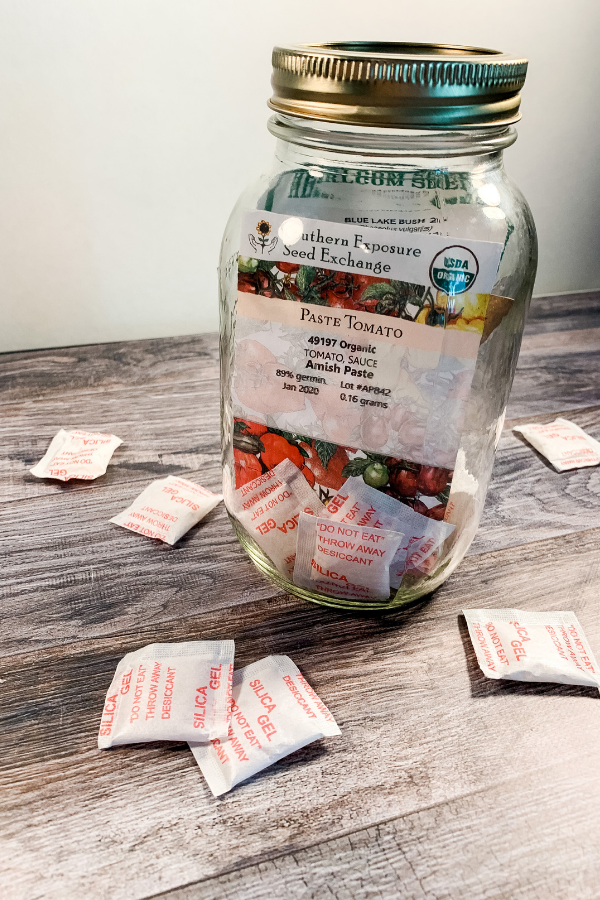How to Store Seeds at Home
Seeds are an investment for any gardener - both monetarily, and in your food future! Follow just a few simple steps to make sure they’re stored correctly for long-term viability.
Storing Seeds at Home
In most areas of the country it is officially winter, gardens have been tucked in, and there’s time to rest before starting spring seeds. If you’re like me you probably have seeds left over from last season - my eyes when seed shopping are usually (okay, always!) bigger than my garden! So what to do with the leftovers?? If stored improperly seed viability decreases and you’ll have much lower (if any) germination. You’ll want to store them correctly to make sure you have viable seeds for the future!
If you think about what plants need to grow - warmth, water, and sunlight - it makes sense that you’ll want to store your seeds cool, dark and dry! Before we take a look at each factor, let’s first take a minute to understand the basics of seeds.
While seeds may seem hard and impermeable, the outer coat of most seeds actually allows moisture and air to pass in and out, as the seed tries to stay in balance with the humidity of the environment around it. If the humidity around the seed is too high the seed will constantly undergo ‘respiration’, moving air and moisture in and out, trying to achieve balance. This uses up more of the energy stored within the seed (which ideally it wants to use for growing!) and makes it age faster, becoming less viable with time. High moisture content also increases the risk of mold or fungal growth, damaging the seed in storage. Thinking of seed moisture and respiration will be helpful to understand as you make plans for seed storage.
Would you like a FREE resource to help you plan when to start your warm-season seeds? Check out this planner I’ve created! Just enter your estimated last frost date and the planner will calculate the earliest dates to start seeds, so you can get a head start on your growing season.
Keep Seeds Cool and Dark
For best seed storage make sure to keep your seeds cool until you’re ready to plant again. Warmer air holds more moisture in it than cooler air, so you’ll want to choose a cool location for your seeds. For short-term storage (less than 2 years), seeds will keep well in a cool spot of your home, out of direct sunlight. A basement, cabinet, or cool closet are great options, just make sure temperatures are consistent - a garage or shed will not make for good seed storage due to fluctuating temperatures and humidity levels. For longer term storage you can also store your seeds in the refrigerator or freezer, just be sure the seeds are nice and dry first - you don’t want any moisture to cause seeds to rot in the refrigerator, or to suffer frost damage in the freezer! If you decide to use the refrigerator try to keep them closer to the back where temperature is more consistent.
Keep Seeds Dry
If you’re planning short-term storage of your seeds (again, less than 2 years) storing them dry and at room temperature will be sufficient. Keep seeds in packets or bags that will allow them to breathe and stay balanced with the air around them, preventing any buildup of moisture. Just be sure they stay in an area with low humidity and at cool temperatures.
For longer term storage you can store seeds in your refrigerator or freezer, but you’ll want to make sure they are sufficiently dry first. There’s a couple of steps that you can easily do at home, with no special equipment needed!
The easiest (and my personal choice!) is to save silica desiccant packets (from shoe boxes, shipped orders, etc) and repurpose them to store with seeds to absorb moisture. For short-term storage I keep my seeds in a bin box and toss a few desiccant packets in with them. If I’m planning for longer storage I start with my seeds first in a sealed container (I use a mason jar with tight lid) with several desiccant packets for about 2 weeks. The desiccant packet will absorb moisture in the air trapped in the jar; as the moisture in that sealed air drops, the seed will send out more moisture from inside of it to maintain balance, resulting in lower internal water content and better long-term storage. Once my seeds have been stored that way for 2 weeks I then take them out, seal them in a plastic bag or container, and put them into the freezer for long-term storage. (note: if you use canning jars you could keep your seeds in there and place it into the freezer, I just get nervous freezing glass, though it can be done)
The desiccant packets that you used for drying your seeds can be used over and over again. To do this, you’ll need to revive them by drying them in the oven - lay packets out on a baking sheet and toast for about 15 minutes at 150F (some sites recommend higher temps, I use this lower temperature to reduce the risk of the packets burning).
If you don’t have any desiccant packets at home there’s a few pantry staples that are great for absorbing moisture! Powdered milk has great moisture absorption capability. To use this, wrap one to two tablespoons in cheesecloth or a tissue, and use with your seed packets for about 6 months. Rice also makes an excellent companion for seed storage because of its ability to absorb moisture. Similar to powdered milk, wrap rice in cheesecloth, a small fabric bag (organza craft bags work great), and store with your seeds. Just be sure to replace it over time.
There’s Always Exceptions
As with many things, there’s always some exceptions to the rules. When it comes to seed storage most home garden seeds will keep well with the steps above, but there are some with notoriously short storage life: okra, onions, parsnips and corn are the usual culprits. You can try to store these in the freezer (remember to be sure they are dry), but don’t be surprised if they are not viable after storage. I purchase fresh seeds of these for planting each season.
Preparing to Use Frozen Seeds
If you’ve chosen to store your seeds in the freezer you’ll want to plan ahead just a bit before starting to plant. When you first remove your seeds from the freezer leave them in the sealed container at room temperature for at least 12 hours, so the jar, air and seeds can come to room temperature, but the seeds remain protected from condensation moisture. After the initial warming up period then open the container so the seeds can be exposed to air and normal ambient humidity for a few days before going to plant.
Will you be storing any seeds this winter? Goodness knows I have plenty in my house! Thankfully with the steps above I won’t have to worry about my seeds losing viability.



